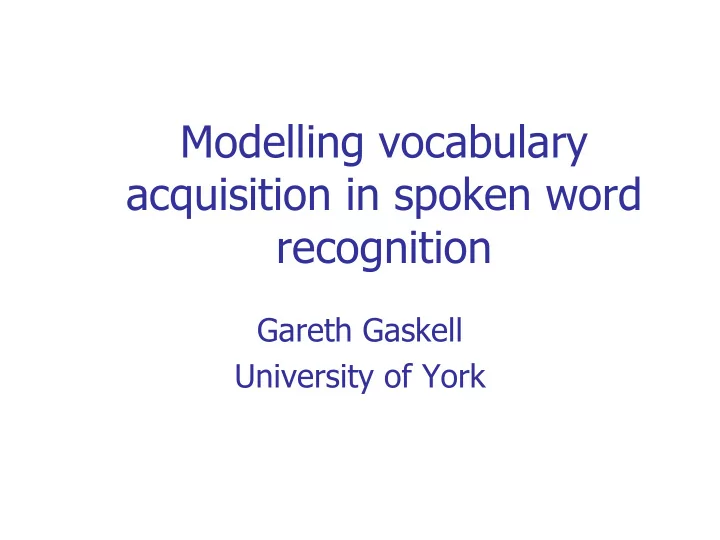

Modelling vocabulary acquisition in spoken word recognition Gareth Gaskell University of York
Models of human spoken word recognition � Box & Arrow - Cohort; Marslen-Wilson & Welsh, 1979) � IAC – TRACE ( McClelland & Elman, 1986) , Shortlist ( Norris, 1993) � ASR-hybrid ( Scharenborg et al., 2003) � ART – ( Vitevitch & Luce., 1999) � Backpropagation – DCM (Gaskell & Marslen-Wilson, 1997) � In these models many aspects of word learning are either impossible or severely downplayed
DCM (Gaskell & Marslen-Wilson, 1997) Distributed lexical Semantic Output Phonological Output representation Recurrent Links Hidden Units Phonetic Feature Input Speech stream
Vocabulary acquisition and the lexicon � Current models of word recognition do not address changes in organisation of the system � developmental changes � changes in adult processing (e.g., phonemic, lexical) � Example: � acquisition of novel words and their impact on lexical organisation
Stick Captain Can Collapse Bed Man Cathedral Cathartic Coat Ear Bread Pit
Stick Captain Can Collapse Bed Man Cathedral Cathartic Coat Ear Bread Speech input: / k / Pit
Stick Captain Can Collapse Bed Man Cathedral Cathartic Coat Ear Bread Speech input: / k / Pit
Stick Captain Can Collapse Bed Man Cathedral Cathartic Coat Ear Bread Speech input: / k / Pit
Stick Captain Can Collapse Bed Man Cathedral Cathartic Coat Ear Bread Speech input: / ki / Pit
Stick Captain Can Collapse Bed Man Cathedral Cathartic Coat Ear Bread Speech input: / kidr / Pit
Stick Captain Can Collapse Bed Man Cathedral Cathartic Coat Ear Bread Speech input: / kidrl / Pit
Novel word learning � What if we teach people a novel spoken word: “cathedruke”? � This should enter the competition process and slow down recognition of existing words
Cathedruke Stick Captain Can Collapse Bed Man Cathedral Cathartic Coat Ear Bread Pit
Cathedruke Stick Captain Can Collapse Bed Man Cathedral Cathartic Coat Ear Bread Speech input: / k / Pit
Cathedruke Stick Captain Can Collapse Bed Man Cathedral Cathartic Coat Ear Bread Speech input: / k / Pit
Cathedruke Stick Captain Can Collapse Bed Man Cathedral Cathartic Coat Ear Bread Speech input: / k / Pit
Cathedruke Stick Captain Can Collapse Bed Man Cathedral Cathartic Coat Ear Bread Speech input: / ki / Pit
Cathedruke Stick Captain Can Collapse Bed Man Cathedral Cathartic Coat Ear Bread Speech input: / kidr / Pit
Cathedruke Stick Captain Can Collapse Bed Man Cathedral Cathartic Coat Ear Bread Speech input: / kidrl / Pit
Lexical access as filling in the features “C…” “Ca…” Time “Cath…” “Cathed…” “Cathedral” Semantic Units Phonological Units
Novel word learning (Gaskell & Dumay, 2003; Dumay, Gaskell & Feng, 2004) � Teach people novel spoken word: “cathedruke” � Immediate effect on explicit memory � people can recognise “cathedruke” easily � Delayed effect on lexical processing � after 24 hours people are slower to recognise cathedral � latest data suggest consolidation during sleep is the key
Delayed lexical competition Recognition Test 560 Response time (ms) 550 540 530 520 510 500 490 Day 1 Day 2 Day 8 Control Novel Competitor
Dual-speed lexicalisation “One-shot” learning Mental Lexicon Localist representation? Hippocampal? Phonological Trace/ Episodic Memory?? Interleaved learning Distributed representation? Neocortical Facilitated by sleep? New Vocabulary
Project proposal � Computationally & neurally explicit model of acquisition and storage of spoken words � Behavioural research � more on time course and informational circumstances underlying lexicalisation and other aspects of learning � Neuroimaging � Investigate neural bases of immediate and delayed aspects of word learning � Computational modelling � connectionist and statistical modelling of above
Behavioural research � More on: � Role of time in lexicalisation � Role of sleep in lexicalisation � Is there a lower limit on degree of exposure to novel items? � Stability of lexical representations � Increase synergies with developmental research
Neuroimaging � fMRI research � neural correlates of one-shot learning and lexicalisation � involvement of sleep � cross-referencing with other types of memory consolidation during sleep � MEG research � track timecourse and localisation of lexical competition for novel items using magnetic MMN (Pulvermüller et al., 2003)
Computational Modelling � Starting point: DCM (Gaskell & Marslen- Wilson, 1997) � biologically plausible � implement dual-speed learning systems � integrate with more sophisticated front end � integrate with other aspects of plasticity (e.g., age of acquisition, segmental adaptation)
Scope of model � Address three bodies of research; so far as possible relating behavioural and neuroimaging data � “steady-state” data on lexical access/lexical competition in speech perception � plasticity, vocabulary learning, lexicalisation � developmental language data
Recommend
More recommend